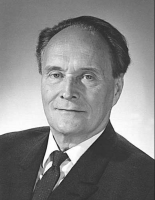










Georgii Frantsevich Gause was a Russian biologist who proposed the competitive exclusion principle, fundamental to the science of ecology. He would devote most of his later life to the research of antibiotics.
Early life & his Research Career
Gause was born December 27, 1910 in Moscow, Russia to parents Frants Gause, a professor of architecture at Moscow State University, and Galina Gause, an industrial worker at an automotive steel plant. As a boy and into his teenage years, Gause and his extended family took summer vacations to the Caucasus Mountains in southern Russia for months at a time.Although his family was not wealthy, they were allowed these respites because his father, being a government architect, helped to build many structures at the university. It was during these trips to the Caucasus Mountains that Gause grew fond of nature, often chronicling the lives and behavior of several organisms including the Siberian Grasshopper (Aeropus sibiricus). The Russian university system requires a faculty advisor for all undergraduate and graduate students. His chosen advisor for his undergraduate career was Vladimir Alpatov. Alpatov, in the mid-1920s, was very impressed by the work of Raymond Pearl, a U.S. demographer who became well-known through his advocacy of the logistic curve.Alpatov brings back a fascination for American science that is very influential on Gause.Gause argued that field work, with too many variables, could never adequately explain this relationship and only in the simplified laboratory environment, where variables could be controlled, would it be possible to determine precisely how a specific ecological factor influences a population. Eager to pursue this mechanistic direction of study and influenced by his advisor, Gause contacted Pearl to see if the American would take on another Russian student. He applied for a fellowship through the Rockefeller Foundation but was denied, perhaps because he was only 22 years old. He then published The Struggle for Existence in 1934 to improve his chances but he was still denied. Gause earned his BSc at Moscow University in 1931 and his DBiolSc in 1940.
In 1932, Gause published what has become known as the competitive exclusion principle, based on experimental work done with mixed cultures of both yeast and Paramecium species.The principle asserts that no two species with similar ecological niches can coexist in a stable equilibrium, meaning that when two species compete for exactly the same requirements, one will be slightly more efficient than the other and will reproduce at a higher rate as a result. The fate of the less efficient species is local extinction.